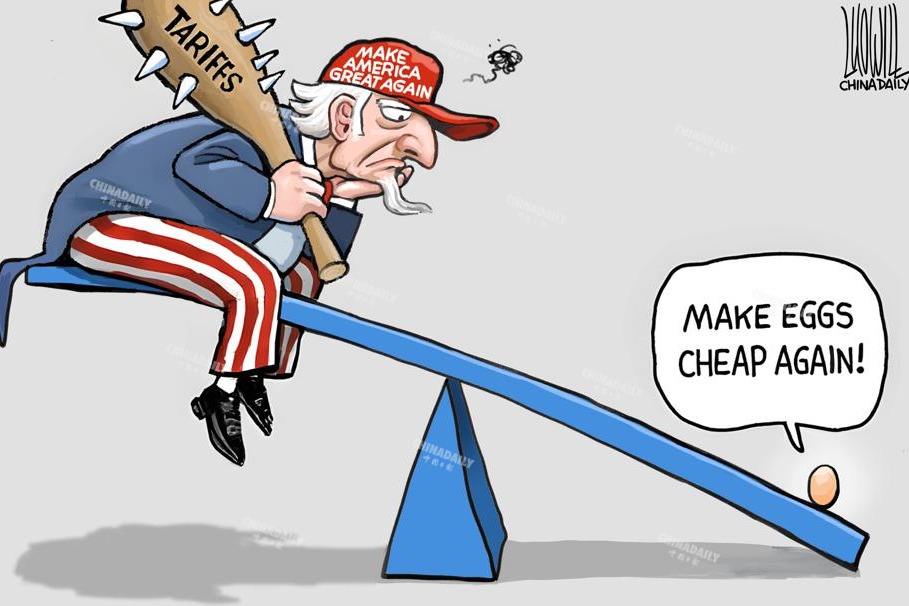Backfire controls


High-tech export restrictions aimed at curbing China's technological advancements are hurting the US
The United States House Foreign Affairs Committee overwhelmingly passed the Enhancing National Frameworks for Overseas Critical Exports Act, or the ENFORCE act, by a vote of 43 to three, on May 23.This legislation aims to enhance the US government's ability to restrict the export of artificial intelligence models, thereby preventing China from developing advanced AI technologies. Since Joe Biden took office, high-tech export controls have become a key tool in the US' strategy to curb China's technological advancements. US National Security Advisor Jake Sullivan has described export controls as "a new strategic asset in the US and allied toolkit". In recent years, the US has significantly expanded its export controls targeting China, intensifying restrictions on both traditional competitive strategic technologies and critical frontier technologies. This approach aims to transform the US' technological edge into permanent dominance, maintaining the nation's hegemony. However, these protectionist measures, instead of securing a competitive advantage for the US, will only backfire.
The continuous escalation of US export controls against China has indeed adversely impacted China's high-tech development. Various essential materials, components and equipment needed for next-generation technology research and development have been included in the export control list. US technical personnel are prohibited from participating in and assisting Chinese enterprises in developing related technologies, and technological exchanges and cooperation are restricted to a small, exclusive anti-China circle. This has created short-term obstacles for Chinese companies in securing tech breakthroughs and revenue. It has also brought uncertainty to China's efforts to realize industrial transformation and upgrading.
However, the actual consequences of arbitrarily imposing high-tech export controls are more detrimental to the US than beneficial. Export controls are a "double-edged sword"; moderate controls can help leading technology countries gain economic benefits and slow down the technological catchup of latecomers. Excessive controls, on the other hand, weaken the technological innovation capability and industrial competitiveness of leading technology countries. Washington's excessive high-tech export controls against Beijing have already caused severe negative impacts for the US itself.
First, these controls harm US business interests. According to a report by the Federal Reserve Bank of New York, export controls have caused a significant reduction in the market value of US companies and a substantial loss of jobs. It estimates that export controls cost the average affected US supplier $857 million in lost market capitalization, with total losses across all the suppliers of $130 billion, and the total number of employees in affected companies has decreased by 7.1 percent. On May 7, the Biden administration further tightened export restrictions on Huawei Technologies Co, revoking licenses for US chip companies Qualcomm and Intel to sell semiconductors to the company. Both Qualcomm and Intel saw immediate impacts on their second-quarter revenue, with Intel's stock price dropping 2.2 percent the next day. Statistics show that the Chinese market accounted for 27 percent of Intel's turnover and 62 percent of Qualcomm's turnover in 2023. Due to export controls in the chip sector, Intel's stock price had already dropped nearly 38 percent in 2024, and Qualcomm's business with Huawei is expected to shrink to zero soon. In the long run, US companies will lose the vast Chinese market as a result of the export controls.
Second, these controls have weakened strategic trust in the US among its allies. The US is attempting to shift the back-blow pressure of its high-tech export controls against China onto its European and Asian allies through long-arm jurisdiction measures such as the Foreign-Produced Direct Product Rule. However, these measures face resistance from allies due to their different levels of economic dependence on China and their different levels of advancement in tech industries. The Biden administration is currently pressuring allies such as the Netherlands, Japan, Germany and the Republic of Korea to take further steps to restrict China's access to advanced semiconductor technology. However, both the Netherlands and Japan have expressed resistance to these additional restrictions. German Chancellor Olaf Scholz has stated his opposition to placing all exports to China under regulation, and the ROK government believes it should be cautious in participating in export controls against China. To maintain its dominance, Washington politicizes, instrumentalizes and weaponizes economic and technological issues, disregarding the economic and technological sovereignty of its allies and sacrificing their economic and security interests. The so-called export control alliance has not helped the US achieve its goal of containing China. Instead, it has prompted countries to introduce competing technological subsidy policies, damaging trust and cooperation between the US and its allies and increasing the coordination costs for the Biden administration.
Third, these controls reduce the US' competitive edge. While export controls can help the US restructure its industrial chains and limit China's access to certain emerging technologies in the short term, this only temporarily delays China's progress without long-term prevention of China's technological strength enhancement. If the US wants to maintain its technological edge, it should actively boost domestic technological competitiveness and upgrade the R&D capabilities of high-tech companies. However, by implementing various containment measures on high-tech exports to China, the US is instead forcing China to seek self-reliant technological alternatives and industrial upgrades. Despite the targeted containment measures from Washington, Huawei still led the global patent application rankings in 2023. The company registered a revenue of approximately 178.45 billion yuan ($24.6 billion) in the first quarter of 2024, a year-on-year increase of 36.66 percent. Moreover, Huawei has made breakthroughs in the MetaERP system, Harmony OS, Euler OS, EDA software, and 5G core components, achieving partial de-Americanization of its high-tech sector.
The US has abandoned maintaining "relative technological advantages" with other countries and instead strives for absolute dominance in key tech sectors. The US perceives China's technological innovation as a fundamental "threat" to its national security and will continue to expand the scope of high-tech export controls against China, imposing unreasonable unilateral sanctions and long-arm jurisdiction on Chinese high-tech companies. Although these high-tech export controls may seem profitable in the short term, they are essentially self-imposed shackles.
In light of this, China should try to further enhance the level of the dependence of US tech companies on its high-tech sector. It is important to leverage the strength of the nation's sound manufacturing system and its large market volume to attract greater US high-tech investment in China, thereby increasing the cost of "decoupling from China "for US companies. It is also important for the nation to actively integrate more into the global innovation network, explore new models of international cooperation, share more of China's development dividends, and promote global knowledge sharing. The differences between the US and its allies in technological development and industrial planning can be employed to break through the US technological blockade. Third, China must expedite its efforts to ensure its core technologies are independent and under its own control, form its own technological advantages, and help domestic companies in building an independent technological supply chain. Meanwhile, China must actively participate in the formulation of global technology standards, and enhance its discourse power in technological standards to precisely counteract the implementation of the US' unequal policy practices against China.
Han Zhaoying is director of the Library of Nankai University and a professor at Zhou Enlai School of Government at the university. Liu Jin is a PhD candidate at Zhou Enlai School of Government at Nankai University. The authors contributed this article to China Watch, a think tank powered by China Daily.
The views don't necessarily reflect those of China Daily.
Contact the editor at editor@chinawatch.cn.



































